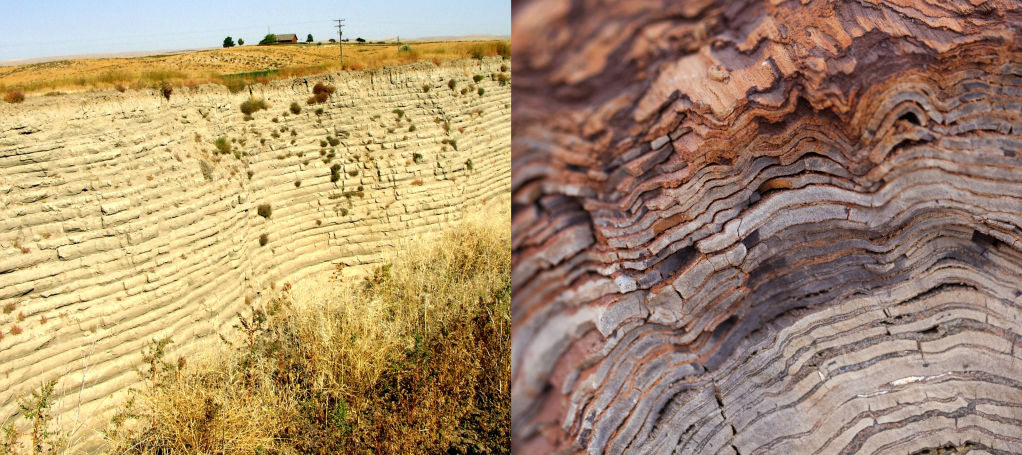Listen to Episode 167 on PodBean, YouTube, Spotify, or wherever you listen to your favorite podcasts!
When scientists examine a formation or fossil assemblage, how do they determine how old it is? In this episode, we discuss the various methods and principles behind Geologic Dating.
In the news
Gaze-following behavior in crocodilians and birds
A pair of fossils are the oldest known pterosaurs from Australia
Dome-headed dinosaurs might have had showy headpieces
Walking adaptations in ancient giant marsupials
How do we know how old a rock or fossil is?
Scientists use two general categories of methods for this: Absolute Dating and Relative Dating.
Absolute dating methods calculate an age by measuring things that change over time. If we know the rate of change and the amount of change that has occurred, we can calculate an age.
The most famous form of absolute dating is radiometric dating. In this case, the change occurring is radioactive decay. Certain forms of certain elements – Carbon-14, Potassium-40, and Uranium-238, to name a few – decay over time and leave behind different elements. For example, for a given sample of Carbon-14, half of the atoms will decay every 5,730 years (that’s the half-life of Carbon-14) into Nitrogen-14. If we have a suitable fossil, we can measure how much decay has occurred and estimate how long ago this fossil organism died.

Different methods of radiometric dating have different uses depending on where they’re found and how quickly they decay. For example, Carbon-14 is great for dating fossils, while Potassium-40 is best for igneous rock layers. Carbon-14 dating is excellent for specimens younger than about 50,000 years, while Potassium-40 dating is great for most of Earth history. There are many naturally-occurring radioactive elements that can be used for dating. Altogether, radiometric dating includes dozens of complementary dating techniques.
There are also many other forms of absolute dating. Fission track dating measures damage accumulated over time due to radioactivity; Luminescence dating measures energy that builds up in certain mineral grains over time; Amino acid racemization dating measures changes in the molecular structure of amino acids; Incremental dating includes many techniques that count regular cycles in naturally-occurring substances, such as the annual rings of a tree or the annual layering of polar ice. All of these techniques provide a specific number, with some wiggle room for possible errors, that gives us the age of a material.

Right: A close-up of tree rings, which are grown annually. Image by Cobalt123, CC BY-NC-SA 2.0
Relative Dating determines the age of one thing relative to another, whether it’s older, younger, or the same age as something else.
Relative dating relies on understanding the order of events in the past. Younger rock layers are deposited on top of older ones, so deeper layers are generally older. If a layer of rocks has been faulted and distorted by an ancient continental collision, then those rocks must be older than the collision event. And so on.
Relative dating also relies on patterns across the geologic record. Over time, various groups of life come and go, so we can use fossils to help us narrow down our age estimate (a specific species of ammonite or trilobite might only be found at a very particular time period, for example). Throughout Earth history, the polarity of our planet’s magnetic field has switched back and forth, leaving recognizable signatures in certain rocks, so the magnetic polarity of a rock can help narrow down its potential age. And so on.

Center: In cases where only certain layers are dated, the layers between them can be dated in relation to those. This is a broad example. Image by Jillcurie, CC BY-SA 3.0
Right: A section of the magnetic time scale of Earth. Black and white sections of the timeline represent normal vs. reversed magnetic polarity. Image by USGS
Consilience is the principle that evidence from many different sources can agree with each other to provide strong conclusions.
The most important thing about all of these dating methods is that they support and complement each other. For any rock formation or fossil assemblage that needs to be dated, multiple methods will be used. A particular mineral might be dated with more than one radiometric technique; a fossil site’s age might be estimated by comparing its ancient animals with several other sites; a worldwide feature like the end-Cretaceous boundary will be dated using many techniques in many parts of the world. Altogether, the many varied methods of geologic dating give us a great deal of confidence when it comes to determining how old rocks and fossils are.

Each type of animal (listed on the right) has a known age range (black bars), which only overlap in a narrow time period (gray line).
This allows the age of the site to be estimated at 4.5-5 million years.
Image from Samuels et al 2018
Learn More
Dating Methods from the Smithsonian Human Evolution website
Geologic Time and Dating Methods from the Digital Encyclopedia of Ancient Life, 2018
__
If you enjoyed this topic and want more like it, check out these related episodes:
We also invite you to follow us on Twitter, Facebook, or Instagram, buy merch at our Zazzle store, join our Discord server, or consider supporting us with a one-time PayPal donation or on Patreon to get bonus recordings and other goodies!
Please feel free to contact us with comments, questions, or topic suggestions, and to rate and review us on iTunes